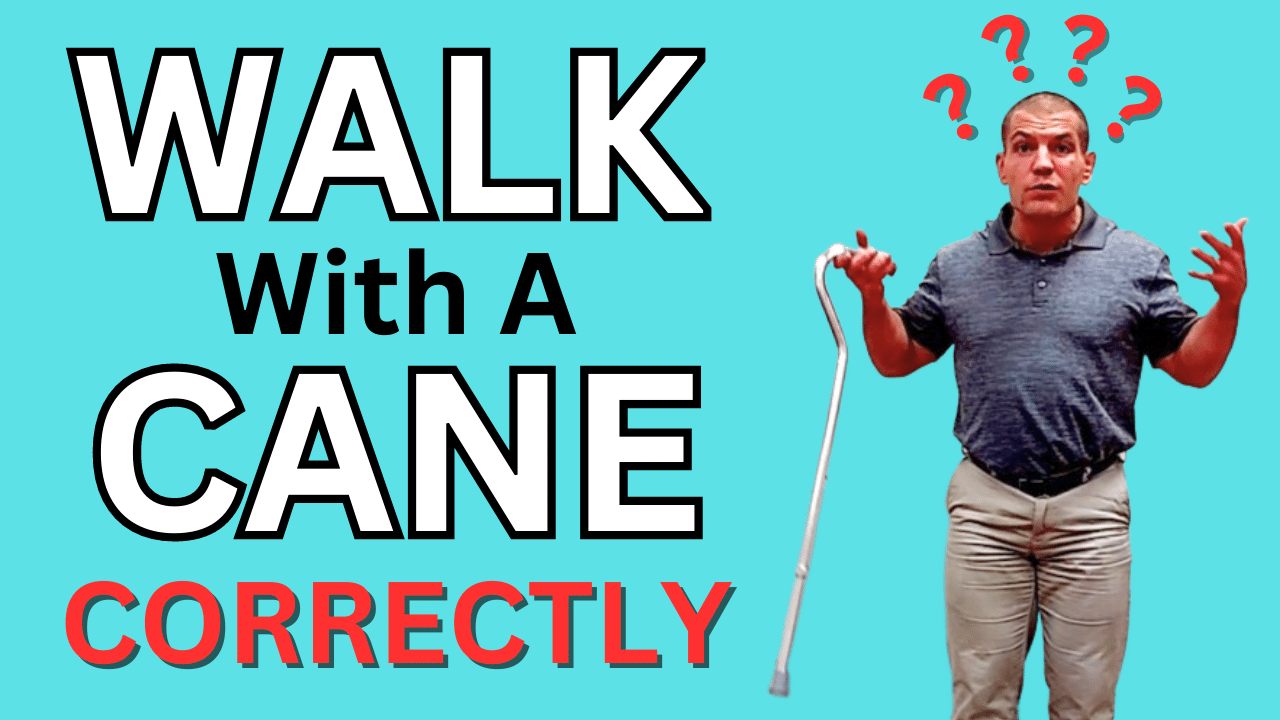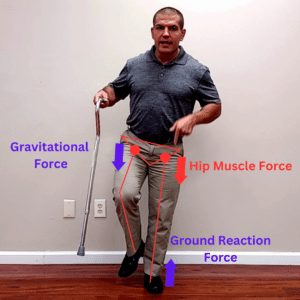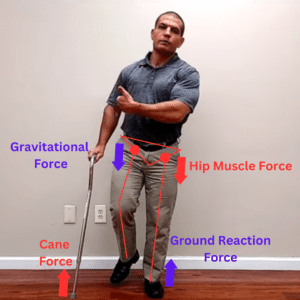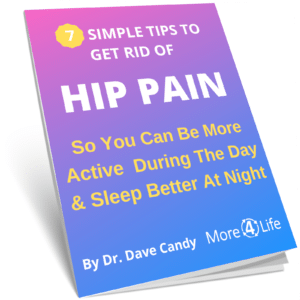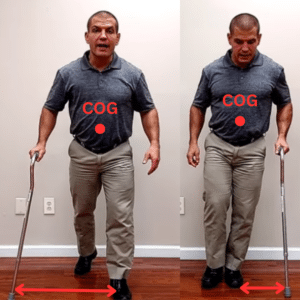If you have knee arthritis or hip arthritis, or perhaps you've had a recent knee surgery or hip surgery, you may find yourself needing to use a cane to walk.
Or maybe your balance isn't as good as it used to be and you feel a little unsteady on your feet.
Using a cane can help you walk more comfortably with less pain and less fear of falling.
But if you're going to walk with a cane, you want to do it correctly.
Watch the video to learn how to use a cane to walk with less hip and knee pain plus better balance.
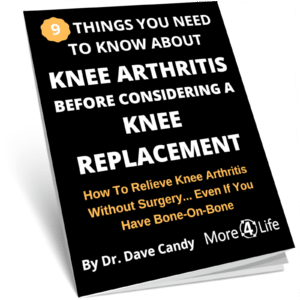
How To Adjust Your Cane To The Proper Height
The first step in using a can is getting your cane adjusted correctly.
A cane that's either too low or too high is not going to help you walk ideally.
When you use a cane to walk, ideally you want your elbow to be bent about 20 to 30 degrees with the cane is six inches in front of you and six inches out to the side.
Another kind of quick rule of thumb is that the can should be roughly the height of your greater trochanter (the bump on the outside of your hip).
What Type Of Cane Should You Use For Hip & Knee Arthritis?
A straight, single point cane is the best type of cane to use if you have hip arthritis or knee arthritis.
It's a good idea to get an adjustable cane, not a one-size-fits-all wooden cane.
DMI Sports Walking Cane and Stick for Ad...
$22.76 (as of July 26, 2024 03:25 GMT -05:00 - More infoProduct prices and availability are accurate as of the date/time indicated and are subject to change. Any price and availability information displayed on [relevant Amazon Site(s), as applicable] at the time of purchase will apply to the purchase of this product.)To adjust the cane, loosen the collar on the cane. Then push the button in until the cane slides.
You pull the tip of the cane out more to make it longer and you push the tip further in to make the cane shorter.
Again, adjust the cane until it's the height of your hip bone and your elbow is bent 20-30 degrees when you hold it six inches out to the side and six inches in front.
Now you're ready to start using your cane to walk.
Which Side Should The Cane Be On?
You would think that you should use your cane on the side that's hurting. However, that's not the case.
You should use a cane on the opposite side of your weak or painful leg.
Why do you use a cane on the opposite side of the injury?
You use a cane on the opposite side of the injury because it helps offload the sore leg.
If you think back in high school physics, you may remember using free body diagrams.
When you're standing on one leg, you've got the fulcrum right at the hip joint of your stance leg. (Keep in mind that the hip joint is actually in your groin region.)
Your leg is pushing down on the ground and pushing up on your hip.
Gravity is pulling your pelvis in a downward on the opposite side of your stance leg.
Without anything to stop you here, you're just going to keep going in that direction. And that's why you put a cane there as a post.
A cane helps push you back up in the opposite direction, and that helps take pressure off of your hip muscles.
Normally, your hip muscles have to do the job of keeping you from tipping over when balancing on one leg.
So when you use a cane, you take pressure off those hip muscles, and therefore, they don't have to work as hard.
If your hip muscles are the cause of the hip pain, which often they are if you get outer hip pain when walking, that makes them feel better.
Additionally, if your hip muscles are weak, that can cause your pelvis to tip over creating hip impingement, which can also irritate hip arthritis.
Hip weakness can also cause your knee to cave inward when walking causing inner knee pain or outer knee pain.
So using a cane actually allows you to walk with a better gait with less hip pain or knee pain.
How To Use A Cane For Balance
The other advantage of having the cane in the other hand is that when you move your leg, the cane at the same time, it gives you a wider base of support.
When you fall, your center of gravity has to move outside of your base of support.
Your base of support is narrow when standing on one leg.
Your base of support is slightly wider using a can on the same side as the sore side.
However, your base of support is MUCH wider if you use the can in the opposite side as the sore side, and also move the can at the same time as you move the sore side.
So for those reasons, you should really try to use the cane in the opposite hand as your sore side and move the cane at the same time as the sore side when walking.
That may seem a little bit counterintuitive, particularly if it means you end up using it in your non-dominant hand.
However, physics doesn't lie.
Try it out for yourself.
What happens if you use a cane on the wrong side?
In theory, using the cane on the wrong side actually increases the demand on your hip abductor muscles. Your center of gravity will also be outside of your base of support since both contact points are to one side of your body.
Some people just do better and can't get the mechanics down, especially if they're using the cane in their opposite hand.
In most cases, it's not the end of the world if that happens. However, you'll likely have less pain and be more steady on your feet if you use a cane to walk correctly.
How Do You Move The Cane When Walking?
Ideally, you want to move it at the same time as the sore leg. You should take some pressure through the arm holding the cane. Don't just tap the ground with it.
When you advance the cane forwards, you want to move it at the same time as the sore leg and ideally have both hit the ground at the same time.
That way, you can put pressure into the cane and take some of the pressure off of that sore leg when you go to take a step.
So that's how to use a a cane to walk correctly if you have hip pain or knee pain.
If you need further help to relieve hip or knee pain, or to improve your balance, we'd be happy to help you. Just tap the button below to request an appointment.

